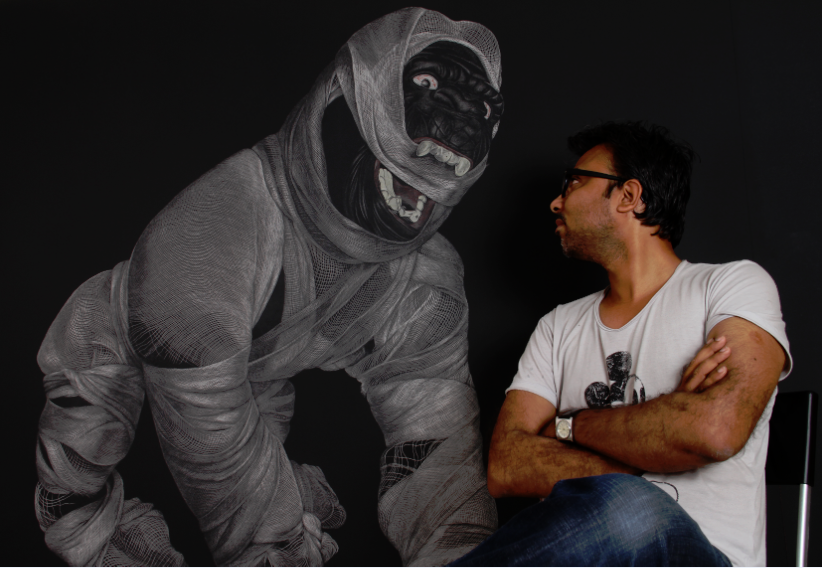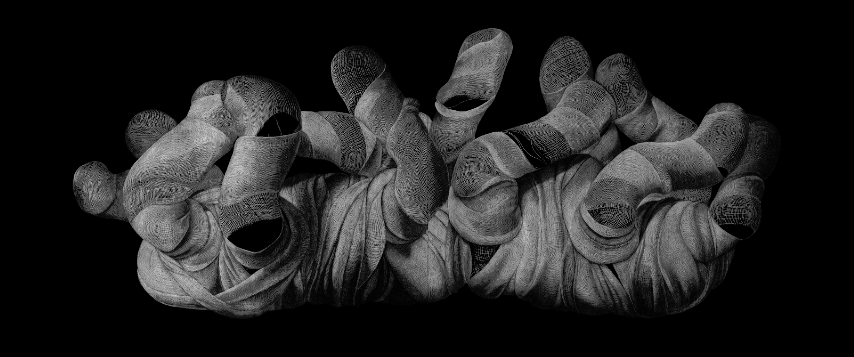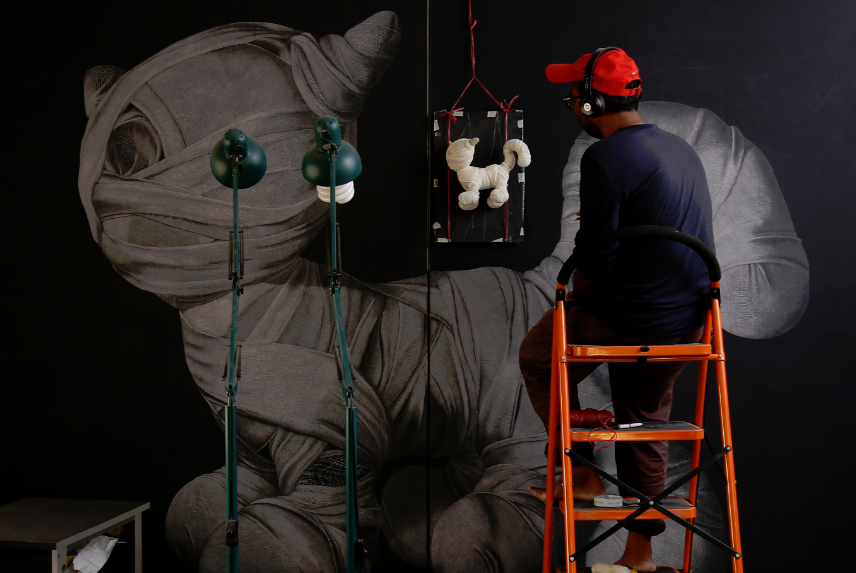Art & Exhibitions
artnet Asks: Adeel uz Zafar on the Saccharine and Scary
Things are less cute than you remember.

Things are less cute than you remember.

Artnet News

Pakistani artist Adeel uz Zafar skillfully blends the pleasant and the unpleasant memories we all associate with childhood. Originally a children’s book illustrator, his work derives its imagery from a collective international pop culture, but the playful cartoon characters he depicts appear in a damaged, far scarier form than we are used to seeing them.
Having recently completed his first US solo show, “Monomania” at Aicon Gallery, Zafar discusses his studio practice, his background, and what we can expect from him next.
Tell us about your recent solo show “Monomania” at Aicon Gallery. What’s next? What are you working on at the moment?
This exhibition presents a survey of my recent work, and highlights two of the signature elements of my practice; the subject matter of children’s toys eerily wrapped in bandages, and my technique of scraping away at a black latex surface, line by line, to give rise to meticulously rendered, seemingly three-dimensional forms. The resulting figures, set against a stark black expanse, are simultaneously haunting, imposing, and imbued with a sense of loneliness. They can represent the isolation and confusion that we sometimes feel in ever-more connected yet somehow increasingly fragmented societies. As cultures clash, ideologies metastasize, and socio-political conflicts and inequalities intensify, my figures, while culled from the collective memories of our childhoods, embody the sense of desperation, helplessness, and darkness that can result from our increasingly complex and volatile global situation.
I can see a subtle development in my work. The characters I represent are beginning to “unhide” themselves. For example, they are emerging from the bandages. But I don’t want to push things to change too quickly and I want a natural progression to take place across the imagery.
I’m looking forward to upcoming national and international shows and participations. At the moment, I am executing new works which are going to be shown at Art Basel Hong Kong 2016.

Adeel uz Zafar, Antagonist / Dragon (2015). Courtesy of Aicon Gallery.
How did your career change after the “Size Does Matter” show in 2009? Would you say it’s been the highlight of your career so far?
I came to prominence in the exhibition “Size Does Matter” at V.M. Art Gallery, Karachi in 2009. The monumental scale of the work, the unusual subject matter drawn from global pop culture, and an innovative “scratch and reveal” technique all seemed to set the work apart from the predominant methods and concerns of the emerging Neo-Miniaturist art scene in Pakistan.
The work in “Size Does Matter” represented a new manner of looking at drawing in Pakistan at the time. It was a revival of works done on a large scale, which by that point had become a rare sight in Karachi, surprisingly! This was a turning point in my career, and catapulted me into the league of emerging artists of Pakistan. It affirmed that working on a large scale not only enlarges the imagery of an artist, it can also vastly expands possibilities and ideas.
When did you know you wanted to be an artist?
I had a normal childhood, and I am the eldest child in my family. I used to play a lot of physical games on the streets and playgrounds. As a child I loved to draw, and I even made drawings on the walls of my house. Then, when I joined school, teachers started noticing my potential and would give me the task of decorating the classroom.
Later, upon seeing my keen interest, my father enrolled me in a short drawing course. It was actually while I was there that I was able to access colleges and universities which offered art as a part of their curriculum. At that point, I thought of “art” as something to be pursued as a hobby—how wrong I was. From just around the time I applied for the National College of Arts in Lahore, and on the very first day in the art college, I understood what I want to become for the rest of life.

Adeel uz Zafar, Drawing Appendage 3 (2015). Courtesy of Aicon Gallery.
What was the transition from illustrator to artist like?
There was no such transition, really. I am still as dedicated as I was as an illustrator, but I feel a greater reward from what I do now as an artist. Except that the younger audience always wants to know why these happy, cuddly characters are being bandaged now, when they were formerly always happy, cuddly, and cheerful creatures in my illustrations.
Describe an average day in the studio.
I would imagine every artist has their own rituals and routines like I do. I am typically a morning person. I have a studio at my house. It’s a large room at the top floor. I teach art in school during the first half of the day. That’s when my brain comes alive with energy, ideas, and inspiration. I usually spend the afternoon in my studio.
By sunset, I’m not very interested in devoting more physical and mental energy to art and try to dedicate some time to my family. I try to be focused when I’m in the middle of executing any work, and spend more time alone in my studio. I often listen to music when I work. I like all kinds of music and, thanks to technology, now you can store as many songs as you want in your phone. The mood, pace and rhythm of the work I am involved with decides what I should listen to. But sometimes even a ringtone or ticking wall clock will do.
Apart from that, an average day begins with checking and sending emails, reading books—I have a small library in the studio—then taking care of Facebook postings, or any other business-type chores that need done. When an artwork is completed to my satisfaction, I sign it and, if time permits, I will sit back and think, and then move onto the next thing.

Adeel uz Zafar at work in the studio. Courtesy of the artist.
What do you like to do when you’re not painting?
I like to be at home to relax and I enjoy watching movies. I have a huge collection of DVD’s and sometimes I think that I should start writing reviews and turn my obsession into another venture, as a part-time critic for a small newspaper or online site.
If you could have dinner with any person, living or dead, who would you choose?
If I could have dinner with any person it would most certainly be a hard decision, but I would have to choose Lady Gaga. I attended her concert “Artpop” in Cleveland two years ago during an artist residency, and I was inches away from shaking her hand. I’d like to discuss her journey and how she has changed as both a performer and as a person over the years. I would ask if she watches her own performances, and how she brands herself and controls her image in the industry.
On a lighter note, I would also try to convince her that I could be a fresher alternative to Jeff Koons when it comes to mingling art and pop, and that I could perfectly drape her in bandages for her metamorphic roles. By the end of the evening I am sure I would look down at my plate and realize I had not had a chance to begin eating the food!
What has been the greatest challenge you’ve faced so far?
For me, originality is an approach or unique idea that departs from traditional and previously proven forms. It’s a very complex term and the definition can be very rigid. Originality is defined as being the quality of inventiveness that exists in something not done before but that is simply unrealistic, because nothing that is thought or created is completely new or not derived from something that’s come before it.
The idea of “pure contemplation” of the subject has never been surpassed and that is the biggest challenge I have faced so far.
What has been the highlight of your career or personal life so far?
I am not going to say it’s always easy, but I feel lucky to be able to create a finer balance between my personal and professional life, and I take that as a highlight. We’ve all faced, are facing, or are bound to face this quandary at some point or another, and this is a challenge that confronts every artist during their career. There is always pressure to present the strongest work ethic and work intensely so that the door remains open for myriad opportunities, but this can come at the price of letting the relationships which matter most disintegrate into alienation.